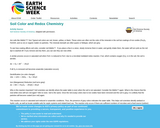
This video discusses the difference between chemical and physical changes.
- Provider:
- Science4Inquiry.com
- Date Added:
- 05/09/2018

This video discusses the difference between chemical and physical changes.

This video discusses the difference between chemical and physical changes.

Students are challenged to find/discover as many physical and chemical properties as they can for samples of matter at various lab stations.

This lesson is designed to exemplify a model-based inquiry approach to practical work. Iron wool is placed on a simple balance and set alight. Will it gain or lose mass? Students use their own ideas (mental models) to make predictions about the outcome of the experiment. They compare their predictions with their observations, and then use the consensus model to develop an explanation. In this case the consensus model is made up of the equation for the reaction, and particle theory.

Students are introduced to molecules, atoms, chemical notation, and chemical compounds through an engaging hands-on wet lab and LEGO brick models of atoms. Students will conduct a chemical reaction, compare physical and chemical changes, and then explore how matter is conserved during the reaction.

This course was created by the Rethink Education Content Development Team. This course is aligned to the NC Standards for 8th Grade Science.

This course was created by the Rethink Education Content Development Team. This course is aligned to the NC Standards for 8th Grade Science.

This course was created by the Rethink Education Content Development Team. This course is aligned to the NC Standards for 8th Grade Science.

In this activity, students observe the iron reduction reaction.

Students investigate some of the physical, chemical and physiological properties of carbon dioxide gas. In addition, a model demonstrating the amount of carbon dioxide in the atmosphere will be constructed.

Students will analyze the bond energy of the reactants and products in a chemical reaction. Students will develop a model to illustrate how the changes in total bond energy determine whether the reaction is endothermic or exothermic.

In this activity, students take water samples from a local waterway. They will test the pH and then conduct a series of experiments to investigate the chemistry of the water.